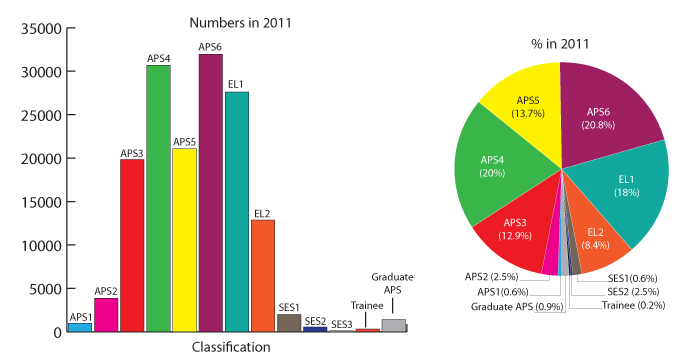About the APS
Government in Australia
There are three levels of government in Australia—Commonwealth, State and Local Government—and each of these levels of government has its own public sector.
The Commonwealth (also known as Australian or Federal Government) public sector comprises both Australian Public Service (APS) agencies and non-APS agencies.
The APS refers to Australian Government departments and agencies where staff members are employed under the Public Service Act 1999.
The APS is part of the Executive arm of the Government. It exercises authority on behalf of the Government, providing the support the Government needs to undertake its roles and responsibilities on behalf of the Australian people.
It does this by providing policy advice and managing and facilitating the delivery of programs, regulations and services agreed by the government. The Australian Public Service (APS) consists of a large number of organisations that provide information, services and support to almost every part of Australian life
Types of Australian (Federal) Government employees
Australian Public Service (APS)
Most Australian Government agencies employ people under the provisions of the Public Service Act 1999 – jobs in these agencies are part of the Australian Public Service (APS).
In the APS you are employed by the agency you work for, on behalf of the Australian Government.
Non-APS Australian Government agencies
‘Non-APS’ agencies are still part of the Australian Government but employ people under their own Acts ― for example, the Australian Security Intelligence Organisation and the Australian Government Solicitor.
They have their own arrangements for advertising and filling jobs, which may include advertising in the Gazette.
Jobs in the Parliamentary Service
People employed in the Parliamentary Service are employed under the Parliamentary Service Act 1999. There are three departments established under the Parliamentary Service Act 1999.
Arrangements for advertising and filling jobs in the Parliamentary Service are similar to those for the APS.
The APS in profile
Over 160,000 people work in the APS across over 120 organisations spread across Australia and the world. The APS Headquarters are located in the Nation’s Capital Canberra, however 60% of jobs in the APS are located outside of Canberra. Many APS organisations have a range of jobs available throughout Australia and overseas.
The organisations are also categorised in size based on the number of APS employees accordingly:
- Large agencies with > 1000 employees
- Medium agencies with 251- 1,000 employees
- Small agencies with 100-250 employees
- Micro agencies with less than 100 employees

Key features of the APS
Key features of the APS workforce in 2010–11 available from the APSC State of the Service Report 2010-11, include:
- at June 2011 there were 97 agencies with 166,495 employees
- the total number of employees rose by 2,013 or 1.2%,
- APS 6 is now the largest classification group
- 57.4% of ongoing APS employees are women
- 13.8% of ongoing APS employees work part-time
Key characteristics of the APS
The APS faces exciting and important challenges in the future. These include;
- increasing complexity of policies and program commitments to meet government priorities,
- changing demographics of the labour market
- technological changes
- the effects of globalisation,
- and increasing financial constraints
These all affect the roles, responsibilities and opportunities available in the APS. The APS offers a wealth of employment opportunities for people to provide innovative and smart solutions to help meet the challenges Australian faces in the future.
Diversity
The APS is a leader in diversity of opportunities. The diversity of the people in the APS is one of its greatest strengths. Diversity in this context covers gender, age, language, ethnicity, cultural background, sexual orientation, religious belief and family responsibilities. Diversity also refers to the other ways in which people are different, such as educational level, life experience, work experience, socio-economic background, personality and marital status. Workplace diversity involves recognising the value of individual differences and managing them in the workplace
Equal Opportunity
The APS follows the principles of equal employment opportunity (EEO). EEO policies address continued disadvantage experienced by particular groups of people in the workplace, including women, Indigenous Australians, people with disabilities and those who suffer disadvantage on the basis of race or ethnicity. These policies remain an important foundation for workplace diversity policy.
APS Values and Code of Conduct
The workplaces in the APS are based on fair and equitable treatment of staff, governed by the APS Values and Code of Conduct. Further information is available at the Australian Public Service Commission website at -
Mobility
The Australian Government encourages the mobility of the APS employees across the Service to obtain diverse career experience. Employees can chose to move across the government agencies for temporary ongoing and none ongoing employment opportunities to enhance their skills and capabilities.
Training & Development
The APS supports professional and personal development, on the job learning, further study, career and leadership training. Each APS organisation provides these to interested staff.
Employment Conditions
The employment conditions in the APS make the APS one of the leading employers of choice in Australia. The key parts that make up favourable employment conditions are:
- good salaries,
- high levels of Superannuation,
- flexible work practices and
- excellent leave conditions
Entry in to the APS
The APS has entry level and management positions, technical positions as well as general administrative or support roles.
Apprenticeship, Indigenous career pathways, school leaver and graduate programs are available across a wide range of APS department and agencies.
Full time, part time, temporary and contract opportunities at all levels of experience exist across a wide range of sectors.
Job Classification
Jobs in the APS are organised segmented based on skills and experience. The classifications are APS 1 – 6, Executive Level (EL) 1 and 2, and Senior Executive Service (SES) Band 1, 2 and 3.
For more information about the expected behaviours at each level, see the Integrated Leadership System (ILS): http://www.apsc.gov.au/ils/index.html
Further information and resources related to the APS are located at the Australian Public Service Commission website - http://www.apsc.gov.au/apsprofile/index.html
Top












